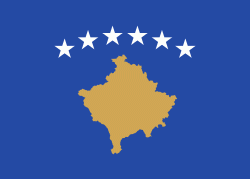Suva Reka (Komuna e Thërandës)
Suhareka (also known as Suharekë and Therandë in Albanian) оr Suva Reka (Сува Река) is a town and municipality located in the Prizren district of central-southern Kosovo. According to the 2011 census, the town has 10,422 inhabitants, while the municipality has 59,722 inhabitants.
Suhareka is located 18 km from the city of Prizren, and 57 km from Kosovo's capital, Prishtina.
Suva Reka means "dry river" in Serbian. The Albanian spellings are Suharekë or Suhareka (derived from the Slavic form), while an alternative name was recently created by the Albanological Institute, Therandë, adopted from an unlocated ancient site (possibly in Suhareka or Lubizhda in the Mirusha valley ).
Suhareka is located 18 km from the city of Prizren, and 57 km from Kosovo's capital, Prishtina.
Suva Reka means "dry river" in Serbian. The Albanian spellings are Suharekë or Suhareka (derived from the Slavic form), while an alternative name was recently created by the Albanological Institute, Therandë, adopted from an unlocated ancient site (possibly in Suhareka or Lubizhda in the Mirusha valley ).
Map - Suva Reka (Komuna e Thërandës)
Map
Country - Kosovo
 |
 |
In classical antiquity, the central tribe which emerged in the territory of Kosovo were the Dardani, who formed an independent polity known as the Kingdom of Dardania in the 4th century BC. It was annexed by the Roman Empire by the 1st century BC, and for the next millennium, the territory remained part of the Byzantine Empire, whose rule was eroded by Slavic invasions beginning in the 6th–7th century AD. In the centuries thereafter, control of the area alternated between the Byzantines and the First Bulgarian Empire. By the 13th century, Kosovo became the core of the Serbian medieval state, and has also been the seat of the Serbian Orthodox Church from the 14th century, when its status was upgraded to a patriarchate. Ottoman expansion in the Balkans in the late 14th and 15th century led to the decline and fall of the Serbian Empire; the Battle of Kosovo of 1389 is considered to be one of the defining moments in Serbian medieval history. The Ottomans fully conquered the region after the Second Battle of Kosovo. The Ottoman Empire ruled the area for almost five centuries until 1912.
Currency / Language
| ISO | Language |
|---|---|
| SQ | Albanian language |
| SR | Serbian language |















